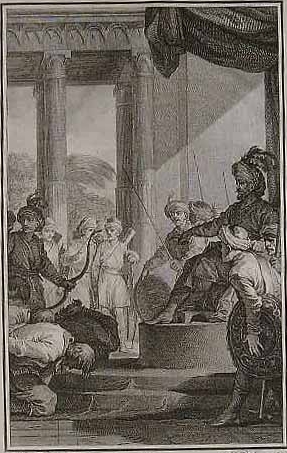| Child’s War | |||||||
|---|---|---|---|---|---|---|---|
| Part of the Anglo-Indian wars | |||||||
 French illustration of Sir Josiah Child requesting a pardon from the Emperor Aurangzeb | |||||||
| |||||||
| Belligerents | |||||||
| Mughal Empire | |||||||
| Commanders and leaders | |||||||
| Josiah Child Thomas Pitt Job Charnock | Shaista Khan Daud Khan Panni Yakut Khan | ||||||
| Strength | |||||||
Total: 3,300
| Total: 980,000
Siege of Bombay [1]
| ||||||
| Casualties and losses | |||||||
Bombay
Madras Unknown | Total [1] Light to none | ||||||

The Anglo-Mughal war, [3] [4] also known as the Child's War, was the first Anglo-Indian war on the Indian subcontinent.
Contents
The English East India Company had been given a monopoly and numerous fortified bases on the western and south-eastern coasts of the Mughal Empire by the Crown, which was permitted by the local governors. In 1682, William Hedges was sent on behalf of the Company to negotiate with the governor of the proto-industrialised Bengal Subah, Shaista Khan, and to obtain a firman, an imperial decree that would allow the English company regular trading privileges across the Mughal provinces.
In 1685, after some breaking of negotiations by Josiah Child, the Governor of Bengal reacted by increasing the tributaries of the trade with the north-east from 2% to 3.5%. The company refused the newly introduced taxes and began to try to get the province of Bengal to accept new terms in favour of the trading power and expressed to capture Chittagong. They also planned to establish fortified enclaves throughout the region, and attain independence of the surrounding subah from the Mughal territory by bringing the local governors and the Hooghly River under their control, which would later allow formation of relationships with the Kingdom of Mrauk U based in Arakan (today's Myanmar) and hold substantial power in the Bay of Bengal. [5]
Upon the Company's request, King James II [6] sent warships to help out the company rule in India, but the expedition failed. [7] Following the dispatch of twelve warships loaded with troops, a number of battles took place, leading to the siege of Bombay Harbour and bombardment of the city of Balasore. New peace treaties were negotiated, and the East India Company sent petitions to the emperor, Aurangzeb, about trade involving the Portuguese at Hooghly and religious intolerance of the Tamil community in Madras, but praised Aurangzeb's imperial majesty and compared him with ancient Persia's emperors Cyrus and Darius. [8] However, the company eventually failed to reach an agreement.
The English naval forces established a blockade of the Mughal ports on the western Indian coast, engaged in several battles with the Mughal Army, and captured ships with Muslim pilgrims journeying to Mecca. [9] [8] [10]
The East India Company navy blockaded several Mughal ports on the western coast of India and engaged the Mughal Army in battle. The blockade started to effect major cities like Chittagong, Madras and Mumbai (Bombay), which resulted in the intervention of Emperor Aurangzeb, who seized all the factories of the company and arrested members of the East India Company Army, while the Company forces commanded by Josiah Child captured further Mughal trading ships. [11]
Ultimately the Company was forced to concede by the armed forces of the Mughal Empire and the company was fined 150,000 rupees (roughly equivalent to today's $4.4 million). The company's apology was accepted and the trading privileges were restored by Aurangzeb. [12] [13] [14]